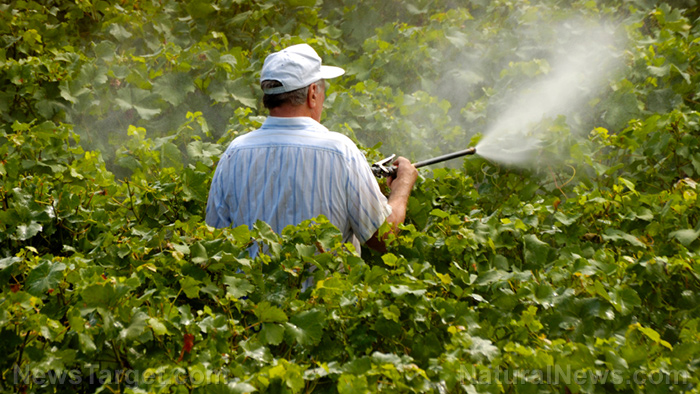Iprodione — toxicity, side effects, diseases and environmental impacts
11/29/2017 / By Earl Garcia

Iprodione is classified as a post-harvest fungicide that controls various fruit and vegetable diseases. The toxic compound is first introduced in 1997 and is commonly used to dampen fungi species that belong to the Botrytis, Minilia, Rhizoctonia, and Sclerotinia families. The chemical works by inhibiting fungal spore germination. The fungicide is commonly applied to both staple and ornamental crops such as carrots, lettuce, and apples. Likewise, iprodione is used on pears, plums, apricots and peaches as well as cotton, sunflower and turf.

List of known side effects
Iprodione exposure may occur through inhalation, ingestion and direct eye and skin contact. Inhaling the toxic compound is known to cause severe respiratory irritation, bronchopneumonia, or pulmonary edema. Likewise, ingesting the hazardous fungicide may trigger the onset of nausea, vomiting, and diarrhea as well as abdominal pain and reduced coordination.
Direct skin and eye contact may also result in severe irritation. An entry published on the Extension Toxicology Network website adds that iprodione exposure may greatly affect reproductive health. Data from various animal studies have shown that the chemical may decrease both prostate and uterus sizes. Likewise, the toxic compound is found to significantly reduce liver and kidney weight. Iprodione exposure may also result in changes in red blood cell production.
Furthermore, an article featured on the open chemistry database Pub Chem reveals that iprodione may contaminate water ways and affect aquatic ecosystems and fishes including carps, trouts, and sunfishes. The fungicide is also harmful to certain species of wildfowl including the bobwhite quail.
Body systems affected by iprodione
Iprodione is notoriously harmful to the respiratory system’s overall health. Likewise, the toxic chemical is found to affect both the digestive tract and the central nervous system. The fungicide is also shown to negatively impact the circulatory system, reproductive health, the kidneys, and the liver. The compound is known to irritate the eyes and the skin as well.
Items that can contain iprodione
An entry published on the Pesticide Properties Database website reveals that many trade name fungicides – such as Rovral WG, Surpass, and Governor as well as 3336Plus and Chipco Green – contain iprodione as a key ingredient. The chemical is available in soluble concentrate or wettable granule formulations. It is widely available across Europe, Australia, and the United States.
How to avoid iprodione
A safety data sheet posted on the Herbi Guide website recommends wearing protective clothing, gloves, and respiratory equipment to reduce the likelihood of iprodione exposure. The data sheet also suggests that workplaces install adequate ventilation to lower the odds of direct chemical contact. The safety guidelines stress that people exposed to the toxic fungicide should contact a poison control center or seek immediate medical help. It is also advisable that victims be taken to an area with fresh air. Likewise, the guidelines recommend that victims thoroughly wash their eyes and skin with plenty of water. The data sheet also advises that people immediately evacuate the area to avoid direct contact on the event of an accidental spill.
Where to learn more
- Fungicide chemicals found to produce autism-like symptoms in animal studies, causing inflammation of the nervous system
- Autism, brain and CNS disorders overwhelmingly linked to people in close proximity to pesticide spraying
- Overused fungicides give rise to deadly, resistant fungus threatening humans and crops
- Exposure to common fungicide causes neurological problems across four generations
- AUTONOMOUS PLANES now weaponized as pesticide delivery platforms to inundate farmland with toxic chemicals
- Denmark discovers an alarmingly high concentration of pesticide poisoning in their population – school children are especially vulnerable
Summary
Iprodione causes severe respiratory irritation, bronchopneumonia, or pulmonary edema.
Iprodione induces nausea, vomiting, and diarrhea as well as abdominal pain and reduced coordination.
Iprodione reduces prostate and uterus sizes, and decreases both liver and kidney weight.
Iprodione is particularly detrimental to the respiratory tract, digestive tract, and the central nervous system.
Iprodione negatively impacts the eyes, skin and both the circulatory and reproductive systems.
Sources include:
Tagged Under:



















